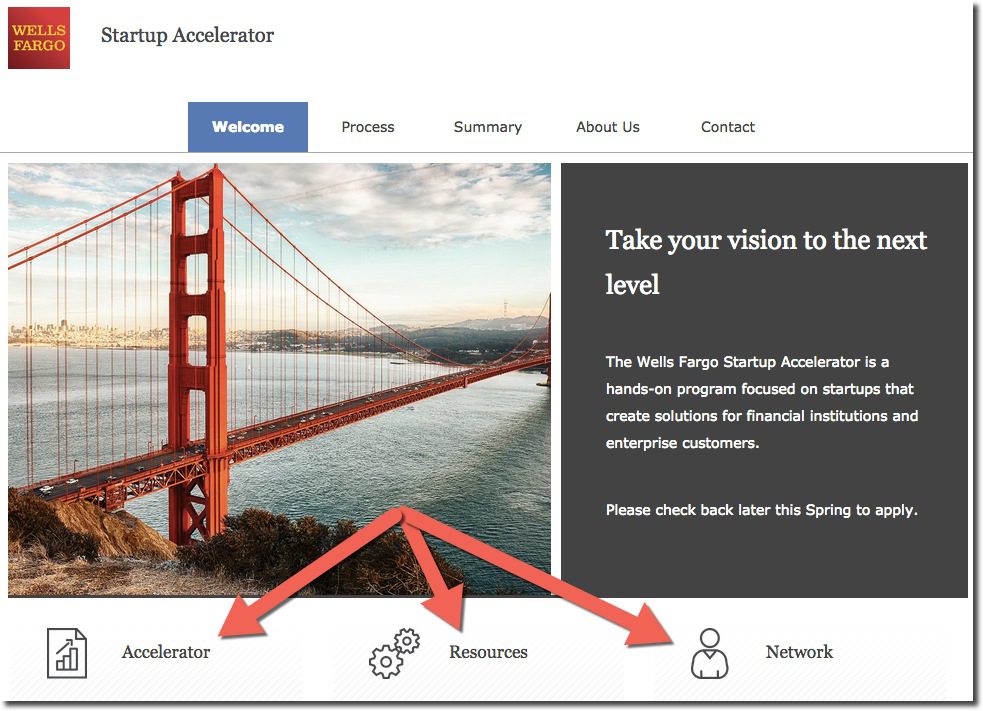
Editors’ Note: There is basically no such thing as “strategic seed investing.” It has just a single hit on Google (when’s the last time you nearly stumped the 30 trillion-page internet?). In traditional startup investing, it’s an oxymoron. If something is truly “strategic,” why would you drop a mere $50,000 into it? Well, if you have mountains of free cash and a high PE, you would shoot for the moon. But banks don’t have either of those, so they need a different model. Hence, I give you Strategic Seed Investing.
————–
As we ready for our two U.S. Finovate events this year (Spring, Fall), we have been thinking about the bigger picture. Not just showcasing exciting new solutions, but actually helping get them implemented. Experts seem encouraged that banks and other financial giants are becoming more active in the fintech investment space. Ken Siegman from WestMonroe Partners points to Wells Fargo’s Accelerator as a great example of the new thinking (see below).
Dozens of large international banks are active venture investors, typically putting $500,000 to $1 million into startups with a “strategic” fit. That way, pure financial returns are boosted by other benefits to the enterprise, whether they are a favorable contract, more attention from the startup’s management, or just pure learning from the various tests conducted by the startup as they explore product/market fit.
But typically, larger companies, be they banks, private equity firms, or other giant pools of cash, stay away from seed investing. The problem is that even quadrupling your $100,000 investment does essentially nothing for the bottom-line of a large corporation, but doubling or tripling a $5 million bet is real money. According to Jennifer Byrne, president of Quesnay, the bigger problem is that the $100,000 investment can eat up nearly the same amount of time for due diligence, monitoring, and mentoring, as the multimillion one. There’s just not a good ROI using traditional measures.
But what if you approach seed investing less as a way to make a financial gain (though that’s always nice) and more as a way to speed adoption of money-saving or revenue-enhancing techniques? So instead of putting seed investing under the domain of Yourbank Ventures, consider classifying its costs as up-front licensing fees that just happen to come with stock warrants/options to help you capture the upside of working with a startup.
Alternatively, take the Barclays approach and let a partner, Techstars in its case, coordinate the mentoring and make the seed investments. The bank can always jump into later, larger rounds. Or team up with other financial institutions in the area to jointly run an accelerator.
Once you have the due diligence costs reigned in, the key to successful strategic seed investing is taking an active role in ensuring that each startup in your portfolio is socialized within the bank, especially finding good pilot opportunities.
Industry examples
In the past 12 months, Wells Fargo, Barclays, and Citibank have all jumped into the seed investing/accelerator space, each taking a slightly different approach:
- Barclays Accelerator: Barclays has been the most aggressive, teaming with TechStars to assemble an accelerator class of eleven companies in 2014. Then just last week, the 2015 class of 10 companies was announced. Each participant in the 13-week program receives extensive mentoring from TechStars and Barclays along with $20,000 in seed money from TechStars in exchange for an undisclosed amount of equity (6% to 10% according to Crunchbase). The program is being replicated in New York City this summer with applications due by May 10, 2015.
- Wells Fargo launched its Startup Accelerator last year (press release). It’s headed by EVP Steve Ellis and began with investments in three startups: Finovate alums Zumigo and EyeVerify along with Kasisto. The first class should be finishing about now if they stuck to the 6-month length mentioned at the time (applications were due 1 Oct). The bank has not posted new details about the next class, just “check back in the Spring.”
- Citibank launched its Mobile Challenge in 2014 with a contest in Latin America and the United States (winners). It is continuing this year with events planned this month in Nairobi, Jerusalem, Warsaw and London. Applicants submit a solution built from Citibank APIs with finalists invited to the demo-day to show it live to a group of Citi staff and other fintech companies. $100,000 in cash prize money is available to be split between two-to-five winners (max prize = $50,000; min = $20,000). It is a cash grant, not an investment. Winners also receive mentoring, help mounting a pilot at Citibank, and potentially receive a contract with the bank.
The bank benefits
Banks can potentially make solid returns on their equity investments, but it’s the combination of internal benefits combined with investing gains, that makes the math work. Let’s walk through an example.
Assuming a 50% survival rate (not easy to do, but not impossible), a $100,000 seed investment per deal, a $50,000 internal cost per deal for due diligence and mentoring of each company, and ignoring follow-on investments (which improve the ROI), banks need the winners to return an average of 2.5x for the effort to break even financially (e.g., a single ‘1x’; a double ‘2x’; a triple ‘3x’; and a home-run ‘4x’).
Here’s how it might work with a $1.2 million budget earmarked for 8 projects:
- Two companies fail to get their minimally viable product off the ground and are quickly written off with minimal bank time expended. Two others hold on longer, but ultimately fail to provide any positive returns.
Cost = $150,000 each ($100k investment + $50k internal cost)
Benefit = $0
Cumulative gain (loss) = ($600,000) - One company has promising tests, but ultimately fails to scale. So it is sold to a competitor for 1x the investor’s money.
Cost = $150,000
Benefit = $100,000 (disposing of assets)
Cumulative gain = ($650,000) - One company is a moderate winner. Tests go well and it’s able to move to the next level by attracting VC funding at double the seed valuation. In addition, the bank is realizing $25,000 per year in cost savings, for an NPV of $100,000.
Cost = $150,000
Benefit = $300,000 ($200,000 stock sale; $100,000 cost savings)
Cumulative gain = ($500,000) - One company is quite successful, attracting a 3x VC round, and saving the bank $100k per year for an NPV of $400,000.
Cost = $150,000
Benefit = $700,000 ($300k stock sale; $400k cost savings)
Cumulative gain = $50,000 - One company hits it out of the park, with VCs bidding the A round up to 4x the seed valuation, and the technology is saving the bank $200,000 annually for a $1 million NPV.
Cost = $150,000
Benefit = $1.4 million ($400k stock sale; $1 million cost savings)
Cumulative gain = $1.3 million
In total, the bank loses $200,000 from a purely financial investment standpoint. But with a $1.5 million gain from implementing the new products, the program has a $1.3 million positive NPV.
Costs = $1.2 mil ($800k invested + $400k internal costs)
Investments returned: $1.0 mil
Internal savings (NPV): $1.5 mil
————————–
Total net: $1.3 million
Bottom line
For best results, banks should focus seed investing not on direct-to-consumer plays, but on back-office process-automation, risk-management tools, or other software with measurable cost savings. That way, the combination of equity returns PLUS cost savings, creates a positive ROI.
Besides the financial gain, there are intangible benefits of working with fintech startups:
- Knowledge transfer: This is the main reason companies benefit from involvement with startups. The startup can run 100s of experiments at a fraction the cost incurred by a large corporation. Learnings from those can be priceless. You can see this happening in the alt-lending space now. Four banks took part in Prosper’s massive $165 million round last week: BBVA, USAA, SunTrust, and JP Morgan. Insights gleaned from insider access to Prosper’s underwriting results could be worth millions, if not tens of millions, for these huge lenders.
- Employee development: As internal IT staff work with outside engineers, there is a good chance that they will learn from each other.
- Quality of work life: I worked at four large corporations back in the day, and I can’t tell you how much I looked forward to the interactions with outside vendors. And as a relatively introverted engineer, it wasn’t for the socializing. I loved learning how outsiders viewed our problems and learned a ton about how they proposed to solve them. And it was a good way to sneak my own ideas into the organization by gaining third-party validation.
- Unintended improvements: This is the opposite of unintended consequences, generally negative aspects of well meaning solutions/policies. By focusing a few smart brains on a problem or opportunity, we often see new solutions/innovations that no one expected. By expanding the gene pool with outsiders, there is a better chance of making an order of magnitude process improvement.
- Brand image: Supporting small business, and tech startups specifically, is good for your image, especially if the firms are local (not always feasible).
—–
Picture credit: AdvertisingAntiques.co.uk
